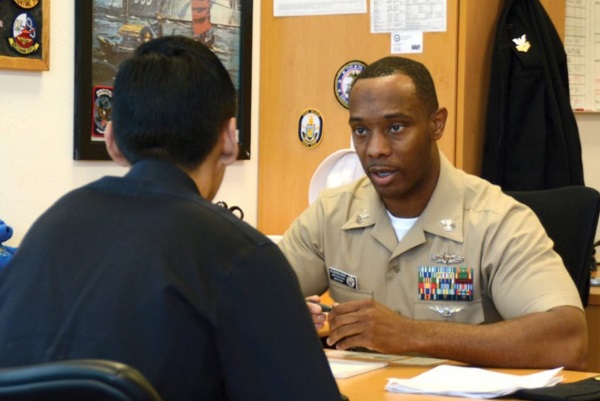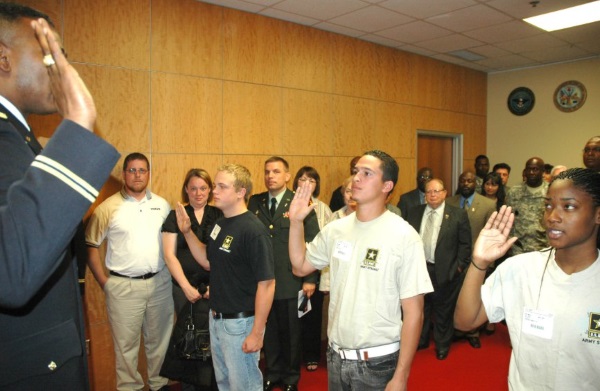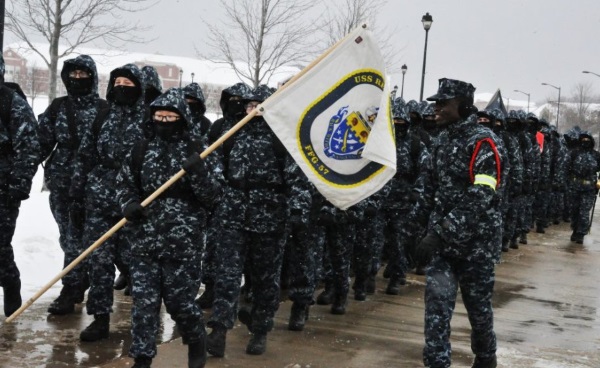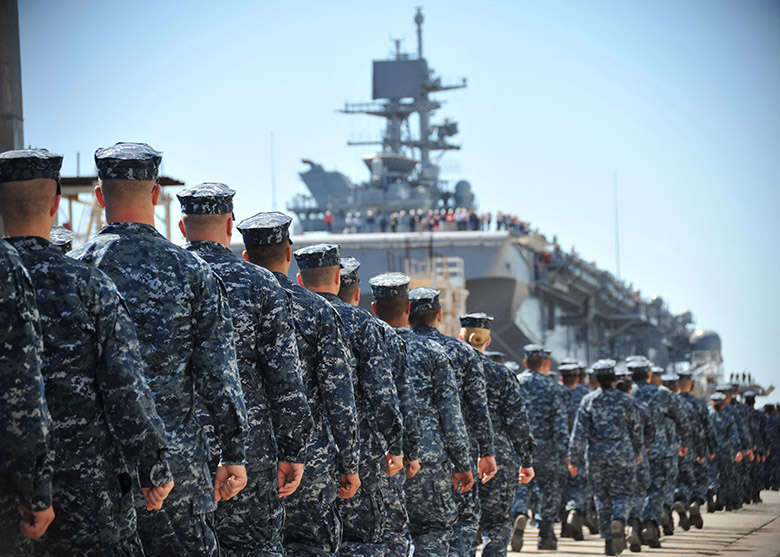So, you want to join the Navy…
Whether you decide to be Enlisted or a Naval Officer, there is a career suited for you.
By joining the Navy as an Enlisted member, you decide on what rate (job) you want to do, receive training for that specialty, and typically sign up for four years and complete your contract with two years as a reservist.
If after you complete active duty and decide the Navy life is the life for you, with a good record, you can extend your contract or re-enlist!
To become a Naval Officer, on the other hand, you must have at least a bachelor’s degree and complete an officer program.
Career professionals such as doctors and lawyers may directly commission into the Navy.
Here are the steps to join the Navy:
Joining the Navy as an Enlisted Member
Meeting with A Recruiter

A recruiter is responsible for ensuring an applicant is qualified and that they are aware of the long-term commitment they are about to make.
All questions should be directed toward a recruiter, as they will either have the answer or know the appropriate person who would know it, ranging from qualifications to benefits and pay.
Related Article: 41 Questions To Ask Military Recruiters
Arrangements to meet with a recruiter can be made using an online locator to find an office nearest you or if the distance is an issue maybe a phone call may be more convenient.
Alternatively, most of the recruiting process can be completed online.
During a typical meeting, a recruiter will guide you through the various career options available, education opportunities, and possibly even cash bonuses.
Think of recruiters as gatekeepers into the Navy.
The more prepared you are to complete the application, the faster the process will go.
Required Documentation
When preparing to meet with a recruiter to fill out an application, it is important to bring the necessary documents with you as this will help speed up the process.
Here is a list of paperwork you may need:
- Birth Certificate
- Social Security card
- Driver’s License
- Passport
- Marriage License or Divorce Papers (if applicable)
- High School diploma
- College transcripts (Official, not copies)
- Contact information for people known for up to 10 years ago
- Full name/Address/Phone number
- Green card (if applicable)
- Copies of Medical Records for any significant injuries/surgeries/illnesses
As the military does medical screenings, it is critical to file appropriate paperwork for any major surgeries or illnesses you have had as they may require medical waivers.
A list of disqualifying ailments can be inquired through your recruiter, check out a short list here.
Every individual applicant has a different background, so it will also be helpful to call ahead to see if other documentation not listed here should be brought in.
Academic / Physical Fitness Evaluations

Assuming you pass the height and weight standards and age limits, you’ll then move on to the Military Entrance Processing Station (MEPS) portion of your recruiting process.
MEPS is where you go to take the Armed Forces Vocational Aptitude Battery, otherwise known as the ASVAB, undergo a physical examination, and choose your job (rate).
Going to MEPS is an entire process of steps, starting the night before after you take the ASVAB.
The ASVAB is a test required for the application process which evaluates a potential member’s aptitude.
It consists of ten short subtests covering the following topics: General Science, Arithmetic Reasoning, Word Knowledge, Mathematics Knowledge, Paragraph Comprehension, Electronics Information, Auto and Shop Information, Mechanical Comprehension, and Assembling Objects.
Practice tests can be found online to take in preparation for the real deal.
The maximum score is 99 and the minimum score to enlist into the Navy is 35.
Based on the overall score and line scores, the ASVAB determines what enlisted careers you are eligible for.
After completion of the ASVAB, you are shuttled to a hotel along with other recruits.
You will be given a meal ticket to have a small dinner, be given a security briefing, and rest before waking up early to be shuttled to MEPS to start the process.
The physical examination and job classification will take a majority of the day, so plan on being there a while.
Once the process is complete, you’ll be sworn in to make it official and then go back home to prepare for the next step—boot camp!
Navy Career Opportunities
The U.S. Navy has a large spectrum of occupations to choose from.
Depending on your ASVAB score you can choose what job best suits you.
Availability upon recruitment may range however, as different rates may not be open until the next cycle.
Related Article: 10 Best Navy Jobs For Civilian Life
Recruiters communicate with Detailers; whose goal is to place members in “Needs of the Navy” billets.
An example of only some of the Navy rates include:
- Air Traffic Controller (AC)
- Boatswain’s Mate (BM)
- Cryptologic Technician (CT)
- Culinary Specialist (CS)
- Damage Controlman (DC)
- Explosive Ordnance Disposal (EOD)
- Gunner’s Mate (GM)
- Hospital Corpsman (HM)
- Information System Technician (IT)
- Master-at-Arms (MA)
- Navy Diver (ND)
- Religious Program Specialist (RP)
- Special Warfare Operator (SO)
- Yeoman (YN)
Click Here to see a full list of enlisted rates with descriptions of the responsibilities and the required ASVAB score.
Boot Camp

New recruits leave for boot camp, or Recruit Training Command (RTC), located at Great Lakes, Illinois which is about 7-9 weeks long.
The program is comprised of conditioning, drilling, various classes, weaponry, and Navy customs and etiquette.
In preparation for boot camp, it may be advantageous to stay in shape and maintain a healthy diet.
Various calisthenics such as running, jumping, pushing, standing and swimming are necessary to pass minimum requirements during the program.
Additionally, there are certain items that you can bring with you such as:
- Wedding ring
- Religious medallion (no bigger than a dog tag)
- Wrist watch
- Pocket Bible
- Small address book
- Prepaid phonecard
- Toiletries (toothbrush/shampoo/soap/comb/deodorant)
- Prescription medication
- Personal identification (social security card/photo ID)
- Direct deposit form from banking institution (if applicable)
- Checkbook/Cash (no more than $50)
- Dependent documentation
- Hair barrettes (Must match natural hair color)
- 1 pair prescription glasses (no contact lenses)
A complete list of items can be found online. If all you wear are contact lenses, military glasses will be issued to you.
For females, undergarments will be issued upon arrival.
Related Article – Navy Grooming Standards: Hair, Mustache, and Nail Regulations
Any unnecessary items brought will be boxed and sent home. If you decide not to bring anything, that is completely fine as you will be provided all necessary items when you arrive.
There will be an opportunity to go to the Exchange to buy items as well.
Bootcamp is a whole new experience and may be a culture shock for some.
New recruits learn the basics, become disciplined, and understand the importance of military bearing.
You’ll also have to successfully meet the standards of the Navy Physical Readiness Test, or PRT.
Upon successful completion of boot camp, Sailors go on to their chosen rate school and ultimately into the Fleet while having been instilled Navy’s highest standards of Honor, Courage, and Commitment.
Joining the Navy as a Naval Officer
Difference Between Officer and Enlisted
Enlisted members constitute a large part of the Fleet and do most work hands-on, whereas Officers make up a smaller portion, manage operations, and are the highest ranking.
To put things plainly, junior enlisted members would be your cashiers, stockmen, and general maintenance of a grocery store; your supervisors would be your staff non-commissioned officers (NCOs) and your Officers would round out the general management roles.
Commissioned Officers oversee and direct operations and command units but rely on enlisted members’ technical abilities to ensure the job is completed.
How to Become an Officer
To not add redundancies and be repetitive, I’ll be more specific when it comes to officers.
There are four ways to become a Commissioned Naval Officer.
OCS
Option one is to join the Navy with a college degree. This route requires the new college graduate to attend Officer Candidate School (OCS), a 12-week program.
OCS is designed to condition an officer recruit to assume the role and responsibilities of a Naval Officer in the Fleet.
ROTC
Option two is by joining while in college through the Naval Reserve Officer Training Corps (NROTC) Scholarship program.
By joining this program, you can continue being a college student while partaking in weekly drills, obtain leadership training, and it pays for school!
Naval Academy
Option three is being a student at the Naval Academy.
Related Article – How To Get Into The US Naval Academy: 5 Challenging Steps
Naval Academy students are midshipmen that train to become commissioned officers on active duty in the Navy while in school.
They attend the academy, graduate with their bachelor’s degree, and begin their Naval career as an officer in one fell swoop.
Direct Commission
Option four is through direct commission.
Career professionals such as doctors, dentists, lawyers, engineers, or chaplains receive commissioning minus the typical prerequisites of the previous three options.
Warrant Officers and Non-Commissioned Officers
Navy Chief Warrant Officers (CWOs) are officers that have advanced beyond the enlisted ranks but still rank below a commissioned officer.
They are technical specialists that perform beyond the rank of a Master Chief Petty Officer (E-9) in their occupational field.
Non-Commissioned Officers (NCOs) are higher-ranking enlisted members who demonstrate leadership abilities and typically start at the rank of E-4.
Related Article: Navy Enlisted And Officer Ranks And Pay
Conclusion
The Navy is an essential branch of the U.S. military that protects the country on and off shore.
There are many perks of being either Enlisted or an Officer, both of which you should consider before you join the Navy.
Some advantages of joining the Navy include but are not limited to free education, high level of financial support, travel, affordable health care, and the everlasting bond created with your fellow sailors.
Whether you decide to join as an Active Duty member or Reservist, the experiences and knowledge that you gain can provide you with a lifetime of pride and sense of accomplishment.
Most importantly, you show selflessness to your country and to the rest of the world—and that is something priceless.
Resources
- Navy Signing, Enlistment, and Reenlistment Bonuses - June 19, 2024
- Navy Health Professions Scholarship Program (HPSP) Guide - June 19, 2024
- Navy Nurse - June 19, 2024
Originally posted on March 26, 2019 @ 6:12 pm
Affiliate Disclosure: This post may contain affiliate links. If you click and purchase, I may receive a small commission at no extra cost to you. I only recommend products I have personally vetted. Learn more.
